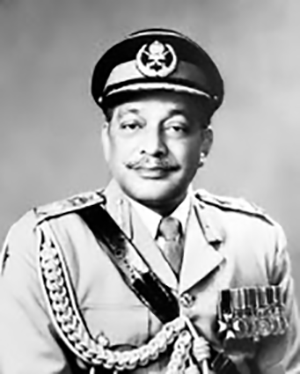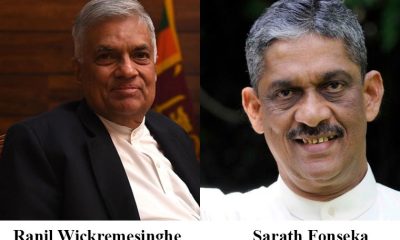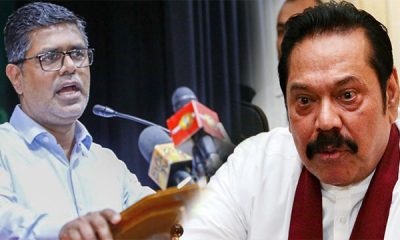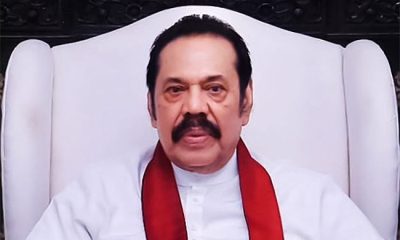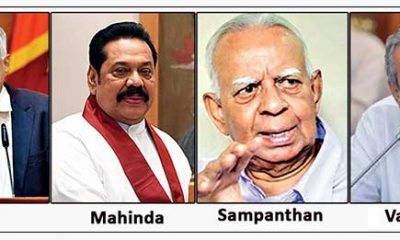Features
JVP 1971 insurrection: April 9 at Tangalle
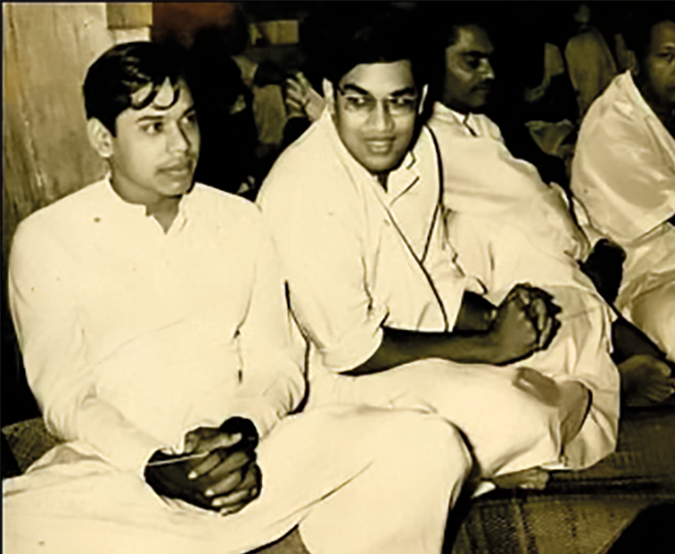
by Capt. FRAB Musafer, 4th Rgt. SLA (Retd.)
(Continued from last week)
Having left the two platoons at Tissa we made our way to Tangalle. The convoy was flattering although the the men in it were limited in numbers. As we approached the police station we were fired upon by a jittery police but fortunately unhurt. ASP Jim Bandaranayke requested me to to do a circuit around Tangalle town as a show of strength to deter any attack on the Prison that was virtually next door and unguarded.
I was leading the convoy when the lights malfunctioned and I asked one of my sergeants to lead the convoy in his jeep and that I would follow him. He went berserk at my request and asked me if I was talking nonsense. “Sir pissu katha karanna epa” to which I responded by reminding him that we were the Army and could not show any fear in the presence of the police. He reluctantly agreed but to my dismay just asked his driver to drive as fast as possible and as a result left the convoy behind.
His action brought home the reality that an element of fear and self preservation was creeping into the soldiers minds. Having driven through the deserted town we returned to the police station and took up positions around the prison.
That night was one of anxiety waiting for an attack that never eventuated. From that day onwards we were permanently stationed at the police station premises. Along with the ASP Jim Bandaranayake there was HQI Inspector Outschoorn, Inspector Boteju of athletic and cricketing fame and a young SI whose name I sadly cannot recall.
It was only recently that I came to know that Inspector Ivan Boteju (later SSP) had defied orders from the highest echelons and refused to surrender to the LTTE. He had fought valiantly until they were overrun and eventually executed in cold blood in Vavuniya. This was soon after the Indian Peace Keeping Force left the island and a peace accord was being brokered. In all a total of over 600 policemen were believed to have been butchered and executed having followed orders to surrender. The treachery of the LTTE!
Whilst in Tangalle the two youngest MP’s, Mahinda Rajapaksa, the former President of Sri Lanka accompanied by the late Anura Bandaranaike called in at the Tangalle Police station proudly displaying their Smith and Wesson pistols given by the Army Commander, Gen Sepala Attygalle. They were provided an Army/Police escort to their residence.
Coordinating officers were appointed in various parts of the island with the dual responsibility of coordinating military operations and restoring normalcy. Colonel Derrick Nugawela, a volunteer officer, was appointed Coordinating officer for Hambantota and set up his headquarters in the Hambantota rest house with Major George Fernando and Capt Ratnasabathy as his Staff officers.
Colonel Duleep Wickramanayke of the Artillery was appointed coordinating officer at Matara with gunner officers of the likes of Capt TonyAbeysena, Lt Neil Dias and Lt Parry Liyanage and Major Nanayakkara (SLI ) to form his team. Officers and men of 3v Gemunu Watch were also deployed in this region.
Colonel Douggie Ramanayake was appointed the Coordinating officer Galle whilst Colonel Ranatunga was appointed to Kegalle. My orders were to remain in Tangalle with specific instructions to secure the prison which in the meantime were filling up with suspected insurgents.
April 10
With Colonel Derrick Nugawela appointed as the Coordinating Officer for Hambantota I was now reporting to him and relieved of a burden of responsibility.On that morning we took some measures to improve the security around the prison and police station. and took up defensive positions that night. There was no attack. In the morning we were informed that the Beliatta police station had been attacked and made a beeline to Beliatta around 6.30 am. The police had repulsed the attack and there were no casualties on either side.
We ventured towards the bus stand that was just across the road from the police station and found a few young men loitering around. When questioned they said they were waiting for the bus. It was strange that there would be that many youth there so early in the day. It soon became obvious when it was observed they all wore boots, condemned army boots with its trademark hole. We rounded them up and handed them to the police.
Some of the things they said were interesting, most had been promised jobs, one in the CTB as manager at Kataragama. When asked how this was to be implemented they replied the older people over age 45-years were to be eliminated to make way for them. I wonder if there was any truth in that statement. None of them had been issued with guns only hand made bombs, those who were issued with shotguns had probably made their escape in a lorry which did not have room forcing them to take the bus.
Meanwhile the country being in turmoil, uncertainty and fear prevailed in the minds of the policemen. There was some tension and discontent at the Tangalle police station as the constables were beginning to feel the strain and wanted to take vehicles out and take the law into their own hands. They were also demanding to see their families in their villages etc. Some of them wanted to burn the houses of suspected JVP sympathizers and also Wijeweera’s mothers house and collect the poultry.
ASP Jim Bandaranaiyke addressed the situation by asking me to take charge and address his men. I did so and imposed my own rules, that no one was to leave the police station premises in any vehicle unless accompanied by the army. They were told that the army would not hesitate to shoot anyone disobeying orders. The wireless operator had then contacted Matara Police and had complained at the conditions imposed on them and the legality of the order, he was told that the Coordinating officer at Matara Colonel Duleep Wickramanayake had threatened to line them up against the wall and shoot them if they failed to comply with the orders given to them. It was accepted that the army was now in charge and from thereon tensions eased.
Some of the smaller police stations were withdrawn to the larger ones. The OIC of Walasmulla Police station refused to withdraw as he had some expensive hi-fi equipment in his home that he did not want to abandon.
In the absence of any intelligence and no concerted insurgent activity in the area we were confined in our task to protect the police station and the prison. The deploying of the Artillery platoon at Tangalle was based more from political pressure as we were a regular army unit whilst two volunteer platoons were sent further south.
During this time the Tangalle Bay hotel was being built and the owner, Dr Wickremasuriya, had the glass panels for safe keeping in the police station premises. I thought it was not the best of ideas having seen the damage caused at Wellawaya. There was no electricity in the region, power was by way of generators requisitioned from the cinema in town. The cold rooms of the Fisheries Corporation was badly affected and as stocks were going bad we helped ourselves to some of the best seafood perhaps of a lifetime, king sized prawns, lobsters and seer fish thereby saving on our ration allowances.
On one occasion we, in a show of force, accompanied the police on information that there were bombs in a coastal village not far from the town reputed for its thugs and violence. What we found was a single homemade bomb hidden away among some plantain trees. There was no one who could confirm it was a bomb; nor did anyone have the expertise to dispose of it. Bomb disposal is a special skill and not something that one should ever attempt.
The police on the other hand thought we could do anything and everything and as such we had to find a solution to impress upon all those around us. I had with me Sgt Jayatilleke who was an army marksman and a sharpshooter and had impressed me when he brought down a young coconut with a single shot of his sterling sub machine gun (SMG) whilst resting in the Tissa police station premises. He came to my rescue by shooting the supposed bomb from a safe distance after having cleared the inquisitive crowd. There was no bang but all were impressed of our capability to do anything.
Each night we anticipated an attack on the prison and police station that never eventuated. On one of these nights Sergeant Jayatillake checking the guard positions accidentally discharged his sterling submachine gun at Bombardier Jayaweera hitting him on his shoulder. It was a situation that created some mayhem. Sgt Jayatilleke came running to me in tears crying out that he had shot Bombadier Jayaweera and in an uncontrollable state of shock threatening to kill himself.
When I saw Bombadier Jayaweera’s injury it was a clean wound well away from his chest, he was in a state of shock but surprisingly cool. He requested me to let him lie down so that he could die there. I assured him that he would not die as the injury was not that serious. We were fortunate that the surgeon of the Tangalle hospital (I think it was Dr Buultjens ) lived next door who attended to him and reassured us that it was not a life threatening injury but recommended that he be taken to the Matara hospital.
As there was a curfew in place, the coordinating officer at Matara Colonel Wickramanayke who was also my commanding officer of the regiment was informed and the injured despatched in an army truck. Sgt Jayathilleke was a mental wreck and had to be sedated for a few days. Bdr Jayaweera never regained the full use of his shoulder and was later retired on medical grounds.
The country was in turmoil, there were many police stations and areas that were in insurgent hands in almost every province except the Northern and Eastern provinces. In Kegalle, Major Jayantha Jayaratne and Capt Sirilal Weerasooriya (who became the Army Commander in 1998) had the opportunity to fire the 76mm Yugoslavian mountain gun for the first time at insurgent hideouts, something deemed a far fetched reality a few years back.. These were the only battle worthy Artillery pieces the Army had at that time.
During the latter period of the insurgency China gifted us with their version of the 85mm field gun. India, Pakistan, America, Britain and Russia had come to our assistance supplying arms and equipment. Rumour was rife that the 24-hour curfew was imposed to ferry arms from Singapore on Air Ceylon planes and that Indian troops were securing the airport and the harbour. There were Indian and Pakistani helicopter pilots flying missions to supply arms and ammunition.
While Tangalle was never attacked nor had been under a direct threat we were being supplied with an array of automatic weapons and ammunition, too much in fact that I that I feared for their security and safety. These drops were interesting in that there was no paperwork issued to acknowledge receipt and the foreign pilots took off no sooner the load was dropped. It was Hi and bye.
Around April 17 Col Nugawela informed me that his staff car was being sent to Colombo for replacement and that I could go home for a day provided I could get some one to hold the fort at Tangalle. The Coordinating officer at Matara obliged by releasing Lt Rohan Liyanage ( Parry). who had hurt himself and could not be used on operational duties.
On my way driving past the Ambalangoda police station premises I saw Brigadier Douggie Ramanayke the Coordinating officer Galle marshalling his troops of the field engineer regiment and Gemunu watch to re-capture Elpitiya as this was a region still under the control of the JVP 12 days after the initial attack.
As there was no means of direct communications (no mobiles) the families of the officers sent out on deployment at very short notice, were constantly enquiring the whereabouts of their spouses from the sweet talking Adjutant Capt Siri Samarakoon who was smart enough to allay their fears with the sweetest of lies. Unfortunately with the prolonged duration of the insurgency he ran out of ideas and was badly caught out.
When I went home unexpectedly that evening my wife asked me if Parry Liyanage was dead . I replied that I was home for a day as it was he who relieved me. She did not believe me and said that some people had even attended his funeral. Parry later confirmed that his mother was subjected to a lot of embarrassment as people had turned up at his home to pay their last respects.
There were so many rumours of all sorts being circulated in Colombo, one of which was the Kataragama murder which had been openly bragged at the CR & FC by Lt Wijesuriya himself resulting in him being investigated and stood down.
(To be continued)
Features
The heart-friendly health minister

by Dr Gotabhya Ranasinghe
Senior Consultant Cardiologist
National Hospital Sri Lanka
When we sought a meeting with Hon Dr. Ramesh Pathirana, Minister of Health, he graciously cleared his busy schedule to accommodate us. Renowned for his attentive listening and deep understanding, Minister Pathirana is dedicated to advancing the health sector. His openness and transparency exemplify the qualities of an exemplary politician and minister.
Dr. Palitha Mahipala, the current Health Secretary, demonstrates both commendable enthusiasm and unwavering support. This combination of attributes makes him a highly compatible colleague for the esteemed Minister of Health.
Our discussion centered on a project that has been in the works for the past 30 years, one that no other minister had managed to advance.
Minister Pathirana, however, recognized the project’s significance and its potential to revolutionize care for heart patients.
The project involves the construction of a state-of-the-art facility at the premises of the National Hospital Colombo. The project’s location within the premises of the National Hospital underscores its importance and relevance to the healthcare infrastructure of the nation.
This facility will include a cardiology building and a tertiary care center, equipped with the latest technology to handle and treat all types of heart-related conditions and surgeries.
Securing funding was a major milestone for this initiative. Minister Pathirana successfully obtained approval for a $40 billion loan from the Asian Development Bank. With the funding in place, the foundation stone is scheduled to be laid in September this year, and construction will begin in January 2025.
This project guarantees a consistent and uninterrupted supply of stents and related medications for heart patients. As a result, patients will have timely access to essential medical supplies during their treatment and recovery. By securing these critical resources, the project aims to enhance patient outcomes, minimize treatment delays, and maintain the highest standards of cardiac care.
Upon its fruition, this monumental building will serve as a beacon of hope and healing, symbolizing the unwavering dedication to improving patient outcomes and fostering a healthier society.We anticipate a future marked by significant progress and positive outcomes in Sri Lanka’s cardiovascular treatment landscape within the foreseeable timeframe.
Features
A LOVING TRIBUTE TO JESUIT FR. ALOYSIUS PIERIS ON HIS 90th BIRTHDAY

by Fr. Emmanuel Fernando, OMI
Jesuit Fr. Aloysius Pieris (affectionately called Fr. Aloy) celebrated his 90th birthday on April 9, 2024 and I, as the editor of our Oblate Journal, THE MISSIONARY OBLATE had gone to press by that time. Immediately I decided to publish an article, appreciating the untiring selfless services he continues to offer for inter-Faith dialogue, the renewal of the Catholic Church, his concern for the poor and the suffering Sri Lankan masses and to me, the present writer.
It was in 1988, when I was appointed Director of the Oblate Scholastics at Ampitiya by the then Oblate Provincial Fr. Anselm Silva, that I came to know Fr. Aloy more closely. Knowing well his expertise in matters spiritual, theological, Indological and pastoral, and with the collaborative spirit of my companion-formators, our Oblate Scholastics were sent to Tulana, the Research and Encounter Centre, Kelaniya, of which he is the Founder-Director, for ‘exposure-programmes’ on matters spiritual, biblical, theological and pastoral. Some of these dimensions according to my view and that of my companion-formators, were not available at the National Seminary, Ampitiya.
Ever since that time, our Oblate formators/ accompaniers at the Oblate Scholasticate, Ampitiya , have continued to send our Oblate Scholastics to Tulana Centre for deepening their insights and convictions regarding matters needed to serve the people in today’s context. Fr. Aloy also had tried very enthusiastically with the Oblate team headed by Frs. Oswald Firth and Clement Waidyasekara to begin a Theologate, directed by the Religious Congregations in Sri Lanka, for the contextual formation/ accompaniment of their members. It should very well be a desired goal of the Leaders / Provincials of the Religious Congregations.
Besides being a formator/accompanier at the Oblate Scholasticate, I was entrusted also with the task of editing and publishing our Oblate journal, ‘The Missionary Oblate’. To maintain the quality of the journal I continue to depend on Fr. Aloy for his thought-provoking and stimulating articles on Biblical Spirituality, Biblical Theology and Ecclesiology. I am very grateful to him for his generous assistance. Of late, his writings on renewal of the Church, initiated by Pope St. John XX111 and continued by Pope Francis through the Synodal path, published in our Oblate journal, enable our readers to focus their attention also on the needed renewal in the Catholic Church in Sri Lanka. Fr. Aloy appreciated very much the Synodal path adopted by the Jesuit Pope Francis for the renewal of the Church, rooted very much on prayerful discernment. In my Religious and presbyteral life, Fr.Aloy continues to be my spiritual animator / guide and ongoing formator / acccompanier.
Fr. Aloysius Pieris, BA Hons (Lond), LPh (SHC, India), STL (PFT, Naples), PhD (SLU/VC), ThD (Tilburg), D.Ltt (KU), has been one of the eminent Asian theologians well recognized internationally and one who has lectured and held visiting chairs in many universities both in the West and in the East. Many members of Religious Congregations from Asian countries have benefited from his lectures and guidance in the East Asian Pastoral Institute (EAPI) in Manila, Philippines. He had been a Theologian consulted by the Federation of Asian Bishops’ Conferences for many years. During his professorship at the Gregorian University in Rome, he was called to be a member of a special group of advisers on other religions consulted by Pope Paul VI.
Fr. Aloy is the author of more than 30 books and well over 500 Research Papers. Some of his books and articles have been translated and published in several countries. Among those books, one can find the following: 1) The Genesis of an Asian Theology of Liberation (An Autobiographical Excursus on the Art of Theologising in Asia, 2) An Asian Theology of Liberation, 3) Providential Timeliness of Vatican 11 (a long-overdue halt to a scandalous millennium, 4) Give Vatican 11 a chance, 5) Leadership in the Church, 6) Relishing our faith in working for justice (Themes for study and discussion), 7) A Message meant mainly, not exclusively for Jesuits (Background information necessary for helping Francis renew the Church), 8) Lent in Lanka (Reflections and Resolutions, 9) Love meets wisdom (A Christian Experience of Buddhism, 10) Fire and Water 11) God’s Reign for God’s poor, 12) Our Unhiddden Agenda (How we Jesuits work, pray and form our men). He is also the Editor of two journals, Vagdevi, Journal of Religious Reflection and Dialogue, New Series.
Fr. Aloy has a BA in Pali and Sanskrit from the University of London and a Ph.D in Buddhist Philosophy from the University of Sri Lankan, Vidyodaya Campus. On Nov. 23, 2019, he was awarded the prestigious honorary Doctorate of Literature (D.Litt) by the Chancellor of the University of Kelaniya, the Most Venerable Welamitiyawe Dharmakirthi Sri Kusala Dhamma Thera.
Fr. Aloy continues to be a promoter of Gospel values and virtues. Justice as a constitutive dimension of love and social concern for the downtrodden masses are very much noted in his life and work. He had very much appreciated the commitment of the late Fr. Joseph (Joe) Fernando, the National Director of the Social and Economic Centre (SEDEC) for the poor.
In Sri Lanka, a few religious Congregations – the Good Shepherd Sisters, the Christian Brothers, the Marist Brothers and the Oblates – have invited him to animate their members especially during their Provincial Congresses, Chapters and International Conferences. The mainline Christian Churches also have sought his advice and followed his seminars. I, for one, regret very much, that the Sri Lankan authorities of the Catholic Church –today’s Hierarchy—- have not sought Fr.
Aloy’s expertise for the renewal of the Catholic Church in Sri Lanka and thus have not benefited from the immense store of wisdom and insight that he can offer to our local Church while the Sri Lankan bishops who governed the Catholic church in the immediate aftermath of the Second Vatican Council (Edmund Fernando OMI, Anthony de Saram, Leo Nanayakkara OSB, Frank Marcus Fernando, Paul Perera,) visited him and consulted him on many matters. Among the Tamil Bishops, Bishop Rayappu Joseph was keeping close contact with him and Bishop J. Deogupillai hosted him and his team visiting him after the horrible Black July massacre of Tamils.
Features
A fairy tale, success or debacle

Sri Lanka-Singapore Free Trade Agreement
By Gomi Senadhira
senadhiragomi@gmail.com
“You might tell fairy tales, but the progress of a country cannot be achieved through such narratives. A country cannot be developed by making false promises. The country moved backward because of the electoral promises made by political parties throughout time. We have witnessed that the ultimate result of this is the country becoming bankrupt. Unfortunately, many segments of the population have not come to realize this yet.” – President Ranil Wickremesinghe, 2024 Budget speech
Any Sri Lankan would agree with the above words of President Wickremesinghe on the false promises our politicians and officials make and the fairy tales they narrate which bankrupted this country. So, to understand this, let’s look at one such fairy tale with lots of false promises; Ranil Wickremesinghe’s greatest achievement in the area of international trade and investment promotion during the Yahapalana period, Sri Lanka-Singapore Free Trade Agreement (SLSFTA).
It is appropriate and timely to do it now as Finance Minister Wickremesinghe has just presented to parliament a bill on the National Policy on Economic Transformation which includes the establishment of an Office for International Trade and the Sri Lanka Institute of Economics and International Trade.
Was SLSFTA a “Cleverly negotiated Free Trade Agreement” as stated by the (former) Minister of Development Strategies and International Trade Malik Samarawickrama during the Parliamentary Debate on the SLSFTA in July 2018, or a colossal blunder covered up with lies, false promises, and fairy tales? After SLSFTA was signed there were a number of fairy tales published on this agreement by the Ministry of Development Strategies and International, Institute of Policy Studies, and others.
However, for this article, I would like to limit my comments to the speech by Minister Samarawickrama during the Parliamentary Debate, and the two most important areas in the agreement which were covered up with lies, fairy tales, and false promises, namely: revenue loss for Sri Lanka and Investment from Singapore. On the other important area, “Waste products dumping” I do not want to comment here as I have written extensively on the issue.
1. The revenue loss
During the Parliamentary Debate in July 2018, Minister Samarawickrama stated “…. let me reiterate that this FTA with Singapore has been very cleverly negotiated by us…. The liberalisation programme under this FTA has been carefully designed to have the least impact on domestic industry and revenue collection. We have included all revenue sensitive items in the negative list of items which will not be subject to removal of tariff. Therefore, 97.8% revenue from Customs duty is protected. Our tariff liberalisation will take place over a period of 12-15 years! In fact, the revenue earned through tariffs on goods imported from Singapore last year was Rs. 35 billion.
The revenue loss for over the next 15 years due to the FTA is only Rs. 733 million– which when annualised, on average, is just Rs. 51 million. That is just 0.14% per year! So anyone who claims the Singapore FTA causes revenue loss to the Government cannot do basic arithmetic! Mr. Speaker, in conclusion, I call on my fellow members of this House – don’t mislead the public with baseless criticism that is not grounded in facts. Don’t look at petty politics and use these issues for your own political survival.”
I was surprised to read the minister’s speech because an article published in January 2018 in “The Straits Times“, based on information released by the Singaporean Negotiators stated, “…. With the FTA, tariff savings for Singapore exports are estimated to hit $10 million annually“.
As the annual tariff savings (that is the revenue loss for Sri Lanka) calculated by the Singaporean Negotiators, Singaporean $ 10 million (Sri Lankan rupees 1,200 million in 2018) was way above the rupees’ 733 million revenue loss for 15 years estimated by the Sri Lankan negotiators, it was clear to any observer that one of the parties to the agreement had not done the basic arithmetic!
Six years later, according to a report published by “The Morning” newspaper, speaking at the Committee on Public Finance (COPF) on 7th May 2024, Mr Samarawickrama’s chief trade negotiator K.J. Weerasinghehad had admitted “…. that forecasted revenue loss for the Government of Sri Lanka through the Singapore FTA is Rs. 450 million in 2023 and Rs. 1.3 billion in 2024.”
If these numbers are correct, as tariff liberalisation under the SLSFTA has just started, we will pass Rs 2 billion very soon. Then, the question is how Sri Lanka’s trade negotiators made such a colossal blunder. Didn’t they do their basic arithmetic? If they didn’t know how to do basic arithmetic they should have at least done their basic readings. For example, the headline of the article published in The Straits Times in January 2018 was “Singapore, Sri Lanka sign FTA, annual savings of $10m expected”.
Anyway, as Sri Lanka’s chief negotiator reiterated at the COPF meeting that “…. since 99% of the tariffs in Singapore have zero rates of duty, Sri Lanka has agreed on 80% tariff liberalisation over a period of 15 years while expecting Singapore investments to address the imbalance in trade,” let’s turn towards investment.
Investment from Singapore
In July 2018, speaking during the Parliamentary Debate on the FTA this is what Minister Malik Samarawickrama stated on investment from Singapore, “Already, thanks to this FTA, in just the past two-and-a-half months since the agreement came into effect we have received a proposal from Singapore for investment amounting to $ 14.8 billion in an oil refinery for export of petroleum products. In addition, we have proposals for a steel manufacturing plant for exports ($ 1 billion investment), flour milling plant ($ 50 million), sugar refinery ($ 200 million). This adds up to more than $ 16.05 billion in the pipeline on these projects alone.
And all of these projects will create thousands of more jobs for our people. In principle approval has already been granted by the BOI and the investors are awaiting the release of land the environmental approvals to commence the project.
I request the Opposition and those with vested interests to change their narrow-minded thinking and join us to develop our country. We must always look at what is best for the whole community, not just the few who may oppose. We owe it to our people to courageously take decisions that will change their lives for the better.”
According to the media report I quoted earlier, speaking at the Committee on Public Finance (COPF) Chief Negotiator Weerasinghe has admitted that Sri Lanka was not happy with overall Singapore investments that have come in the past few years in return for the trade liberalisation under the Singapore-Sri Lanka Free Trade Agreement. He has added that between 2021 and 2023 the total investment from Singapore had been around $162 million!
What happened to those projects worth $16 billion negotiated, thanks to the SLSFTA, in just the two-and-a-half months after the agreement came into effect and approved by the BOI? I do not know about the steel manufacturing plant for exports ($ 1 billion investment), flour milling plant ($ 50 million) and sugar refinery ($ 200 million).
However, story of the multibillion-dollar investment in the Petroleum Refinery unfolded in a manner that would qualify it as the best fairy tale with false promises presented by our politicians and the officials, prior to 2019 elections.
Though many Sri Lankans got to know, through the media which repeatedly highlighted a plethora of issues surrounding the project and the questionable credentials of the Singaporean investor, the construction work on the Mirrijiwela Oil Refinery along with the cement factory began on the24th of March 2019 with a bang and Minister Ranil Wickremesinghe and his ministers along with the foreign and local dignitaries laid the foundation stones.
That was few months before the 2019 Presidential elections. Inaugurating the construction work Prime Minister Ranil Wickremesinghe said the projects will create thousands of job opportunities in the area and surrounding districts.
The oil refinery, which was to be built over 200 acres of land, with the capacity to refine 200,000 barrels of crude oil per day, was to generate US$7 billion of exports and create 1,500 direct and 3,000 indirect jobs. The construction of the refinery was to be completed in 44 months. Four years later, in August 2023 the Cabinet of Ministers approved the proposal presented by President Ranil Wickremesinghe to cancel the agreement with the investors of the refinery as the project has not been implemented! Can they explain to the country how much money was wasted to produce that fairy tale?
It is obvious that the President, ministers, and officials had made huge blunders and had deliberately misled the public and the parliament on the revenue loss and potential investment from SLSFTA with fairy tales and false promises.
As the president himself said, a country cannot be developed by making false promises or with fairy tales and these false promises and fairy tales had bankrupted the country. “Unfortunately, many segments of the population have not come to realize this yet”.
(The writer, a specialist and an activist on trade and development issues . )

